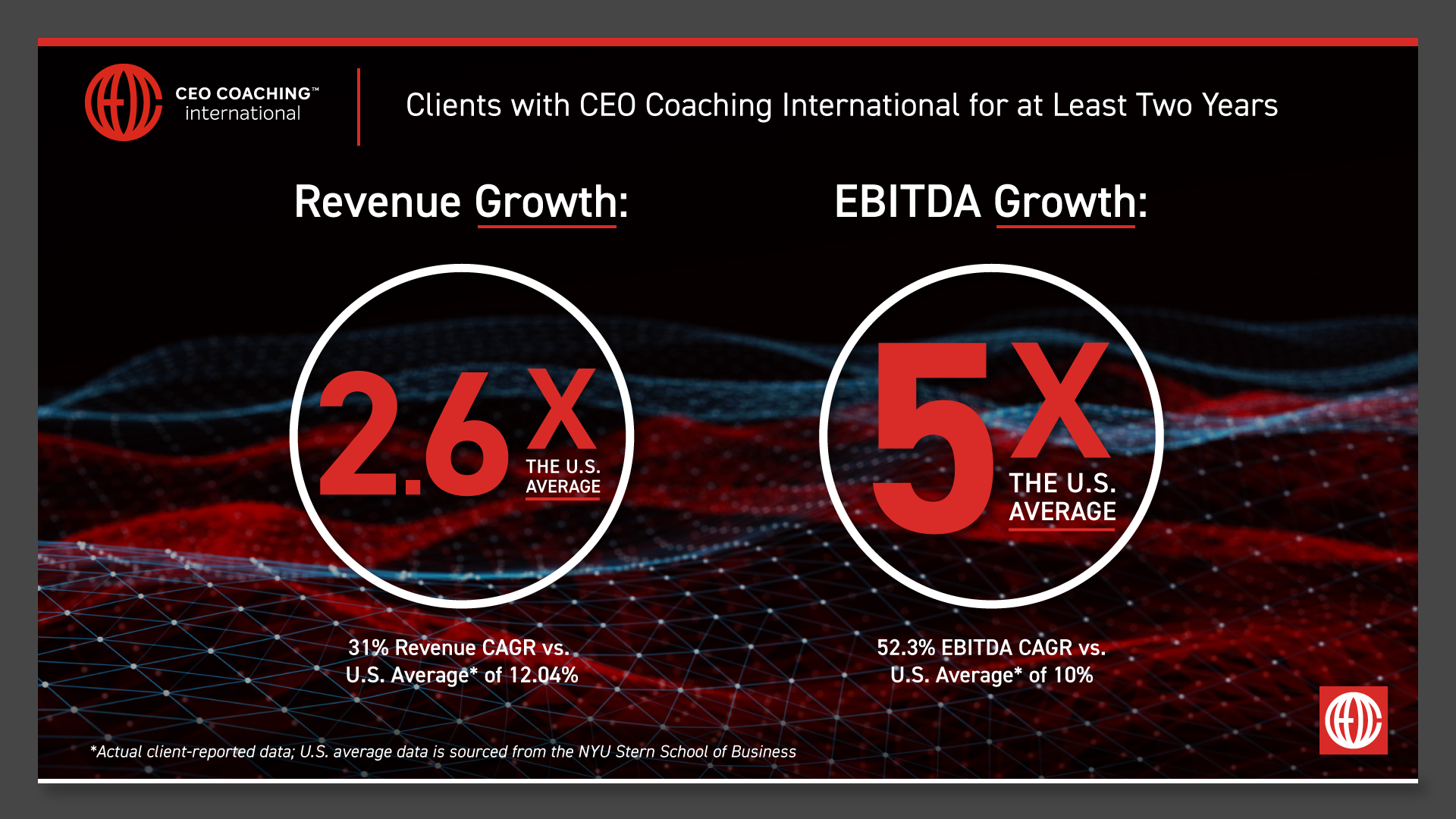
The challenges of the past year have given all CEOs a new perspective on work and family. But navigating boundaries and balancing responsibilities has been especially tough for CEOs in charge of family-run businesses.
Many of the 350-plus companies we work with at CEO Coaching International are owned by families. And many of the conversations we’ve had with these entrepreneur coaching clients during this unprecedented time of change have touched on similar topics such as:
- How does a family business reinvent itself for a digital future while preserving its heritage?
- How do you manage long-time employees who are either unwilling or incapable of adapting to new market realities – especially when you’re related?
- Is reaching outside the family to fill key positions going to push the company forward or tear the family apart?
- How can founders who are eying retirement preserve their life’s work and prepare the next generation to take control?
In the weeks ahead, our new content series focused on family-run businesses will help CEOs answer these and other questions. To get started, I hosted a webcast with three experts who know how to channel a family’s passion and pride into making BIG happen.
Joining me were:
- Ramona Cappello, a coach at CEO Coaching International. Ramona is an entrepreneur and a seasoned executive with experience at major companies including Kendall-Jackson Wineries and Nestle.
- Mike Marchi, a coach at CEO Coaching International. Mike is a senior business executive with a history of improving financial and operational performance resulting in increased shareholder value. Mike’s experience includes leadership roles in public, private equity and family-owned privately held global corporations including General Electric, Citibank, Kohler, American Standard, Grohe, Lixil and SK Capital.
- Jamil Nizam, CEO of Waldom Electronics and a client of CEO Coaching International.
Balancing meritocracy and harmony.
Jamil Nizam’s father started Waldom in 1967 in a two-bedroom apartment. Since then, the company has grown to three operating businesses and $500 million in revenue. Jamil is one of seven siblings who are second generation stakeholders in the business. Add in seventeen emerging stakeholders from the third generation and you can understand why Jamil has struggled with his competing responsibilities.
“I was the CEO at work and at home,” Jamil says. “I would walk into a room full of my siblings and the fun would stop. I remember thinking that no amount of success was worth having a disconnected family. My goal has been to have a successful family business that’s based on meritocracy and family harmony. I believe most family businesses might get one of the two, and I’m striving for both.”
To achieve that harmony, Jamil knew he had to open stronger lines of communication within his family. So, he started an annual siblings retreat where he and his fellow gen two stakeholders gain alignment on both family business and the family business. Jamil also authored an important document to help the family maintain perspective on big-picture goals and explore ways to give back together.
“I decided to write Nizam family principles,” Jamil says, “which is a guide for our family that talks about our history and our values and what we stand for and how we want to treat one another. We then created a family foundation. And that’s a tool for us also to get gen three involved in managing money and things like that. And recently we joined a family office that is really committed to family values and trying to bring up the future generations as responsible people.”
Planning for the future today.
The next generation has been front of mind for many family business CEOs recently. COVID-19 is a powerful reminder than none of us can predict what’s coming next in our personal lives or in our businesses. The best safeguard against the unexpected is a clear succession plan that avoids two common stumbling blocks.

“The first is the person that’s put into the leadership role doesn’t want the role, but they’re thrust into it,” says Mike Marchi. “And the second is, you don’t want to take somebody who’s too young and put them in the CEO role of a $300 million business and not have them get experience in some of the functional areas of the business first. Find family members that want to be part of the business, and then start grooming them early. It’s not just a check the box, they have to really be successful in those roles. And they have to earn that role to be successful and then continue to elevate up through the organization.”
“Sometimes, the older generation assumes that the child has absorbed everything about the business,” adds Ramona Cappello. “And that’s not necessarily setting them up for success. We have to be very intentional about developing people and giving them exposure to all aspects of the business. Potentially have them work outside the business, for at least two reasons: one, they will bring a different perspective into the business, and two, they will build self-esteem and credibility amongst their peers and the people that will work for them because they could achieve success elsewhere and bring that learning inside the business.”
It’s also important to appreciate what a difficult spot even the most capable second-generation stakeholders are in. Do well, and the public will say it’s because the founder was a genius. Stumble, and it’s because the founders’ spoiled kids couldn’t cut it.
When it was time for the second generation to take the reins at Waldom, Jamil and his siblings understood that they really had to take responsibility for this next stage of the company’s history. Jamil remembers, “I huddled my siblings up about 10 years ago and my message to them was, ‘We’re on the clock. If the business is a success, if the business fails, it’s because of us. We should own that while still honoring our history, but we need to make decisions and play to win instead of playing not to lose.”
Take the good and make it BIG!
Like Ramona and Mike, I’ve coached CEOs who have really struggled with the complex dynamics of a family-owned business. I’ve worked with second-gen CEOs whose “retired” parents couldn’t stop micromanaging. I’ve seen companies buckle under the strain from marriages and divorces. I even coached two brothers who were equal business partners, never spoke to each other, and essentially wanted me to cast tie-breaking votes and break the bad news to the loser. When business drives that kind of a wedge between family members, it’s devastating for both the people involved and the company’s long-term prospects.

However, I’ve worked with far more CEOs like Jamil who have used the family’s principles as a guiding light for the family business. Every family has its fair share of disagreements. Families who work together, maybe even more so. But once the dust settles, the strength of our bonds usually pulls us back to those we love with a deeper level of understanding and a renewed sense of purpose. Companies that learn to tap into the power of those familial bonds can create a BIG competitive advantage that will last for generations.
“Family-owned businesses do live up to their reputation,” notes Ramona Cappello. “They come with some real interpersonal challenges. But the opportunities to grow a brand and business grounded in the pride for heritage can be even greater. After all, there are many, many businesses out there who build culture around treating everyone like family. And I would contend that every entrepreneur’s journey, whether they manage a family business or not, is indeed, at its heart, a family business.”
For more granular details on succession planning, creating an independent board, family shareholding strategies, and much more, check out the video replay of our webcast. We’ll be posting more installments to this series on family-owned businesses in the weeks ahead.
About CEO Coaching International
CEO Coaching International works with CEOs and their leadership teams to achieve extraordinary results quarter after quarter, year after year. Known globally for its success in coaching growth-focused entrepreneurs to meaningful exits, CEO Coaching International has coached more than 1,000 CEOs and entrepreneurs in more than 60 countries and 45 industries. The coaches at CEO Coaching International are former CEOs, presidents, or executives who have made BIG happen. The firm’s coaches have led double-digit sales and profit growth in businesses ranging in size from startups to over $10 billion, and many are founders that have led their companies through successful eight, nine, and ten-figure exits. Companies working with CEO Coaching International for two years or more have experienced an average revenue CAGR of 31% (2.6X the U.S. average) and an average EBITDA CAGR of 52.3% (more than 5X the U.S. average).
Learn more about executive coaching | Meet our world-class coaches





